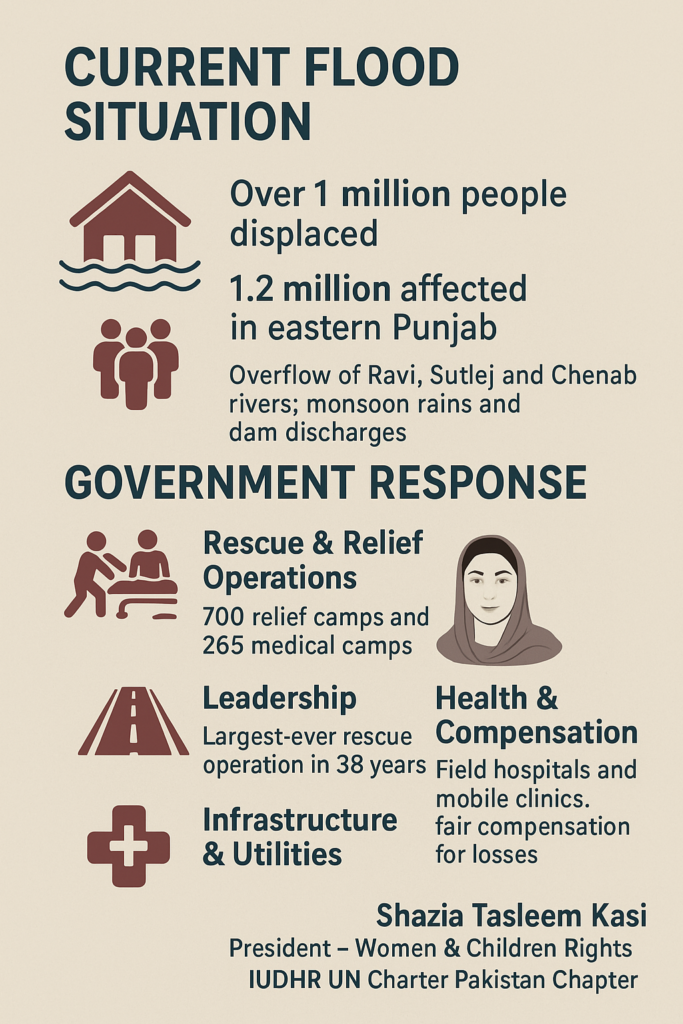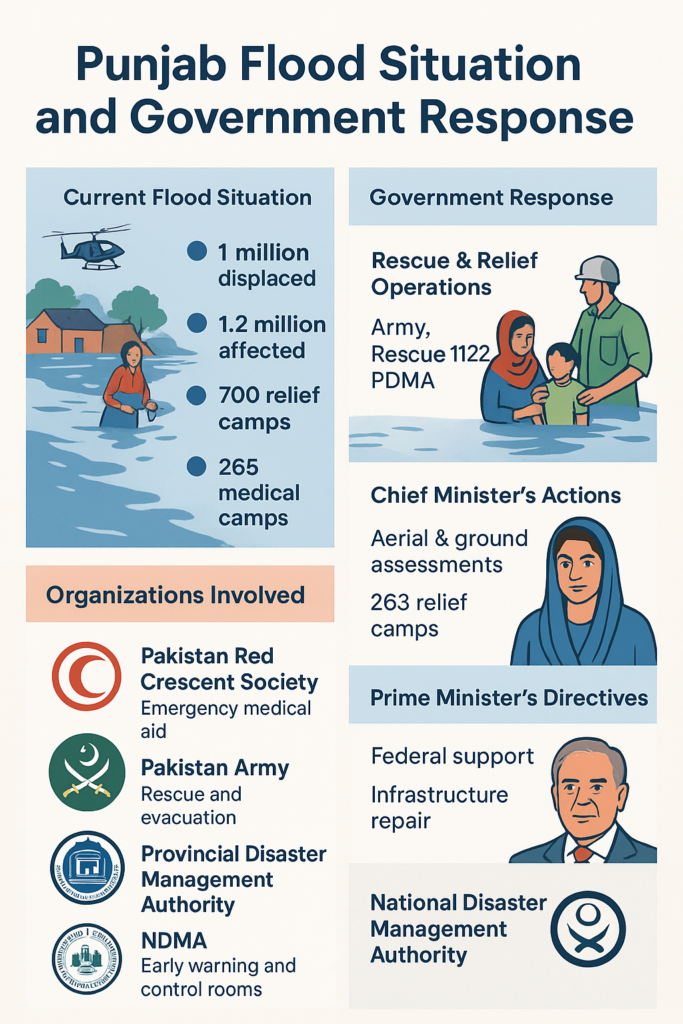Introduction: Punjab Flood Situation and Government Response
A devastating flooding event has affected eastern Punjab, with over 1 million people displaced and approximately 1.2 million affected. The catastrophe was caused by the overflow of the Ravi, Sutlej, and Chenab rivers, along with heavy monsoon rains and upstream dam discharges. In response, the provincial disaster authority has initiated a large-scale rescue operation, establishing around 700 relief camps and 265 medical camps to assist the affected communities.
This report is presented by Shazia Tasleem Kasi, President of Women and Children Rights.
IUDHR UN Charter Pakistan Chapter.

Current Flood Situation and Government Response
This flooding crisis is considered one of Punjab’s most severe in recent history, causing widespread displacement and damage. The government’s response has been comprehensive, focusing on early warnings, coordinated rescue efforts, the deployment of relief camps, and structured compensation mechanisms. The Prime Minister’s Office and federal ministries have strengthened intergovernmental coordination and infrastructure repair.
Chief Minister’s Actions
In what has been described as the largest rescue effort in 38 years, Chief Minister Maryam Nawaz Sharif deployed the Army, Rescue 1122, Police, Civil Defense, and the Provincial Disaster Management Authority (PDMA) across seven key districts. The Chief Minister has conducted aerial and on-ground assessments and has ordered special girdawari assessments for fair compensation for losses. Additionally, she has activated field hospitals and mobile clinics specifically for vulnerable populations, including women, children, and the elderly.

Prime Minister’s Directives
Prime Minister Shehbaz Sharif has emphasized the need for federal support, which includes coordination through the NDMA, strengthening early warning systems, and providing logistical reinforcement. This support includes supplying tents, repairing infrastructure, and ensuring public services are maintained.
Design of the Relief Effort
The relief effort is designed with several key components:
- Preparedness & Early Alerts: The National Disaster Management Authority (NDMA) and PDMA issued timely warnings and activated control rooms to mobilize rescue teams before the disaster peaked.
- Multi-Agency Coordination: A swift response was ensured through collaboration among multiple agencies, including the NDMA (federal), PDMA (provincial), the Pakistan Army, Civil Defence, Rescue 1122, Police, and various district administrations.
- Rescue, Relief & Health Services: Helicopters and boats were deployed to evacuate stranded individuals and livestock. Medical camps were established, and essential supplies like food, water, and hygiene kits were distributed in both remote and urban areas.
- Damage Assessment & Compensation: Girdawari (damage surveys) have been implemented across the affected areas to ensure transparent compensation for losses of crops, livestock, homes, and infrastructure.
- Infrastructure Restoration & Long-Term Strategy: A long-term strategy includes rebuilding roads, restoring utility services, and developing water storage solutions to mitigate future flood threats.
Organizations and Actors Involved
Governmental Bodies
- National Disaster Management Authority (NDMA): This federal-level body is responsible for coordination and early warning systems.
- Provincial Disaster Management Authority (PDMA): The PDMA leads the provincial response, including setting up camps and coordinating efforts.
- Pakistan Army: The Army has been deployed in key districts for rescue, evacuation, and logistical support.
- Rescue 1122, Civil Defence, and Police: These groups are on the ground, conducting operations, providing first medical response, and coordinating with local administration.
Humanitarian and Civil Society Actors
- Pakistan Red Crescent Society (PRCS): With 1.8 million volunteers across Punjab, PRCS is a key provider of emergency medical and relief services.
- Alkhidmat Foundation: An NGO with a strong volunteer base, often active in disaster relief.
- Al Mustafa Welfare Trust (AMWT): A rapid responder organization offering meals, medical camps, and hygiene kits in the Lahore and Rawalpindi regions since mid-July 2025.
- Native Youth Club for Climate Change (NYCCC): A youth-led organization that provides food, hygiene kits, medical support, and long-term resilience programs.
Conclusion
Federal-province collaboration and the activation of multiple agencies have been critical to the success of the response. Civil society has played a vital and complementary role, providing grassroots relief and medical aid. Organizations like the PRCS, Alkhidmat, AMWT, and NYCCC are a testament to the community’s resilience in the face of this severe crisis.
Article By:
Shazia Tasleem Kasi
President of Women and Children Rights, Pakistan
IUDHR – UN CHARTER PAKISTAN CHAPTER
